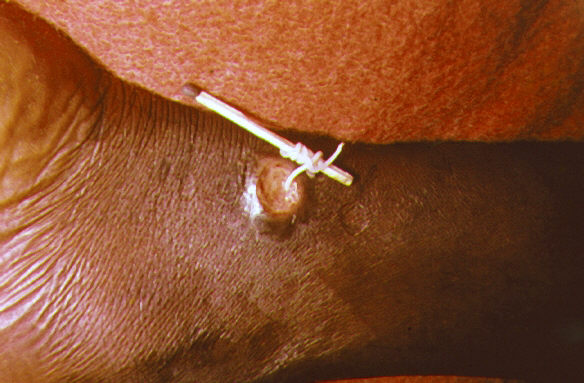Just four months after Guinea worm disease in South Sudan was declared “transmission interrupted”, three people in the town of Rumbek have been diagnosed with the disease, the first cases in South Sudan for more than 18 months, according to a UK Telegraph report.

Image/CDC
Until these reported cases, the last diagnosis of the disease in South Sudan had been in December 2016.
Chad and Ethiopia each reported 15 cases in 2017. Those 30 were the only cases in the world in 2017; when The Carter Center began leading the Guinea worm eradication campaign in 1986, there were an estimated 3.5 million cases annually in 21 countries on two continents.
Considered a neglected tropical disease, Guinea worm disease (dracunculiasis) is contracted when people consume water contaminated with tiny crustaceans that carry Guinea worm larvae. The larvae mature and mate inside the patient’s body. The male worm dies. After a year, a meter-long female worm emerges slowly through a painful blister in the skin. Contact with water stimulates the emerging worm to release its larvae into the water and start the process all over again. Guinea worm disease incapacitates people for weeks or months, reducing individuals’ ability to care for themselves, work, grow food for their families, or attend school.
Jimmy Carter: ‘I’d like for the last guinea worm to die before I do’
Without a vaccine or medicine, the ancient parasitic disease is being wiped out mainly through community-based interventions to educate and change behavior, such as teaching people to filter all drinking water and preventing contamination by keeping patients from entering water sources.
- Parasites 101: Ascaris lumbricoides
- Paragonimus: A look at this parasitic lung fluke
- Clonorchis sinensis: The Chinese liver fluke
- Acanthamoeba: A rare and potentially blinding parasite
- Parasites 101: Whipworm
- Dientamoeba fragilis: ‘The unflagellated human flagellate’
- Lymphatic filariasis in Nigeria: The battle against the disfiguring parasitic disease
- Parasites 101: Pinworms
- Parasites 101: Entamoeba histolytica
- Diphyllobothrium: The largest known tapeworms that can infect people
- Parasites 101: Swimmer’s itch
- Parasites 101: Cyclospora


